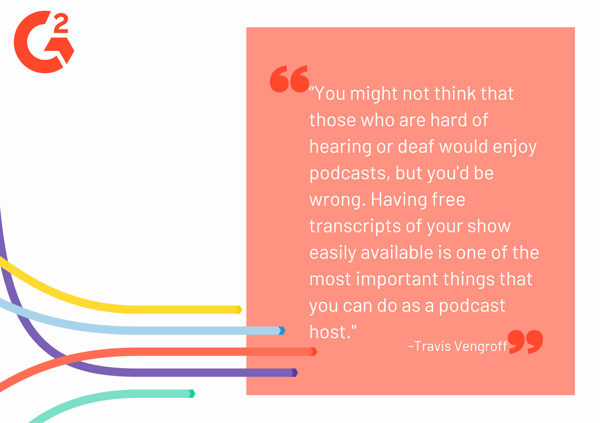Podcasting has exploded onto the digital landscape — but that doesn’t mean it’s equally available.
Based on primarily audio content and distributed through smartphone-centric directories, podcasts have a few hurdles to cover in order to allow differently-abled people to participate in this latest permutation of the online content revolution.
Web accessibility is a vital step in the content creation journey. Not only is making your podcast easily available for all groups a good idea for growing your audience, but equal access to the resources of the internet is something we should all strive to accomplish.
5 podcast accessibility tips from the experts
We reached out to several podcast hosts for their insights on the best ways to achieve accessibility on podcasts. See a tip you like? Feel free to jump ahead:
- Transcripts are key
- Audiograms
- Video elements
- Other transcription benefits
- Leverage platforms like Facebook and YouTube
1. Transcripts are key
Travis Vengroff, Producer/Sound Designer at Fool and Scholar Productions
Our first example touches on how important it is to dismantle our own misconceptions about accessibility and podcasts. Below is some insight from Travis:
“You might not think that those who are hard of hearing or deaf would enjoy podcasts, but you'd be wrong. Having free transcripts of your show easily available is one of the most important things that you can do as a podcast host. Failure to do so prevents you from reaching a large audience that might enjoy your show. A number of budget-friendly transcription services exist if your show is unscripted.

As a generally audio-based medium, it's also important to describe any visual action or humor or use sound design to tell any component of your story that relies on visuals.”
A good way to accomplish this can be through creating a detailed podcast script. Writing out a script is not just a good way to help organize your thoughts going into a show, it can serve as the basis for your transcript.
2. Audiograms
Charlie Patel, CEO of Podcasts.com
Charlie Patel breaks down a few different options available to podcast hosts, most notably the use of audiograms to turn the mp3 files of podcasts into a video-based mp4 that can be played by listeners who might be hard of hearing:
“There are a few recent technologies that podcast hosts can offer to podcasters which are directly beneficial to hearing or visually impaired.
The first is audio transcriptions of each episode so that the text can easily be accessed via the website. The second is audiograms which will convert audio to video format with animated text overlays of the spoken words. The responsibility for implementing these sophisticated features to offer support for all audiences to enjoy such content rests on the awareness and willingness of both podcast hosts and podcast creators. At Podcasts.com, we are soon releasing our fully updated platform which will include such amazing features, and more, at an affordable price point to support the community.”
Audiograms are also a great way to promote your content and can be used to re-release snippets of an episode you want to feature! There are a lot of benefits to using this technology.
3. Consider adding a video element
Heather Teysko, Host of the Renaissance English History Podcast
This response discusses the value you can add to your podcast by making a video element. Heather breaks down how she goes about creating video content to supplement each episode:
“I've started noticing that if I make a video of each episode, and add in subtitles, it makes a big difference for my audience. Many people actually find my podcast through my Facebook page or group; they don't know about my show, and they become listeners thanks to finding me through FB. I have had a few people mention to me that they are hard of hearing, and would like to listen, but have a hard time with it.
So the first thing I do is create a blog post with the transcript (my show is scripted and I write out each episode in advance, so this is easy for me to do, but if you don't have a scripted show you can use automatic translators like through Temi which is 10 cents/min or you can have it done by a real person through Rev at $1/min). That means that people can read instead of listening. This also helps with SEO, which is a bonus! I also then create a video with the transcript, which I put on YouTube. So hopefully I'm reaching as many people as possible with those easy changes.”
While the end result might sound similar to an audiogram, podcasters who incorporate video from the getgo generally have a much higher-end product that goes beyond simply incorporating animated words floating over a still image.
4. Other transcription benefits
Nihar Suthar, Host of the Chasers Podcast
Aside from being a critical step for making your show more accessible to a deaf audience, transcriptions are a great way to help non-English speakers access your content! Nihar points out that, among other things, transcriptions are a great way for people to work through your shows at their own pace:
“The greatest and easiest piece of advice I have for making your podcast more accessible is to transcribe it and link it in a blog post. This is useful for multiple reasons:
1) Allows people who have hearing deficiencies to still be able to consume the content of your podcast.
2) Allows people who are still learning English or the language your podcast is in to be able to better consume the content of your podcast.
3) Helps your podcast be more discoverable through SEO.”
|
Looking for more ways to make inclusive content? Check out the best web accessibility software at G2 for real user reviews on what to try.

|
5. Leverage platforms like Facebook or YouTube
Bri Seeley, Entrepreneur, Author, and Host of the ‘But, How?’ Podcast
Our final contributor discusses how other platforms such as YouTube and Facebook can transform the accessibility of a podcast. Closed captioning is a useful tool for podcasters who aren’t able to provide full written transcriptions:
“It's important to me that anyone who wishes to consume my podcast episodes be able to do so. I repurpose my podcast content across multiple channels so listeners can access it through audio or video (with or without subtitles). Every episode of 'But, How?' is accessible on audio platforms, then uploaded to Youtube and Facebook with closed captioning. In the past, I've also included full written transcriptions of every episode on my website.”
The path forward
With the growth of podcasts showing no signs of slowing, it’s crucial to continue to implement and discuss issues of accessibility. The sooner content creators begin to habitualize the inclusion of differently-abled groups of people, the more opportunity we will have to enrich the cultural fabric of our society with a vast array of perspectives. The internet’s main power is the connection it affords, and we owe it to each other to incorporate everyone into that sphere of discourse.
If you need some help getting started with your show, check out our guide on how to start a podcast.
 by Piper Thomson
by Piper Thomson
 by Piper Thomson
by Piper Thomson
 by Piper Thomson
by Piper Thomson